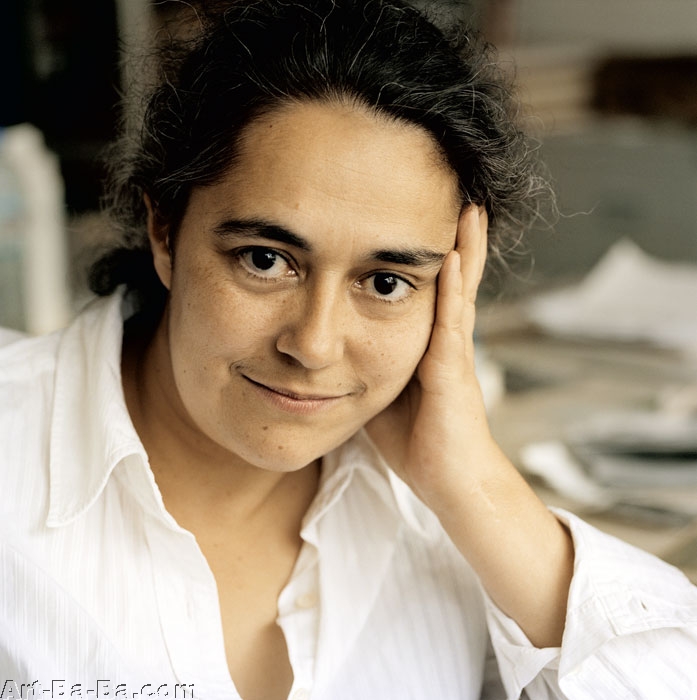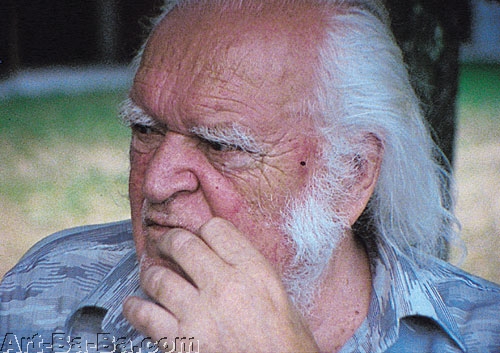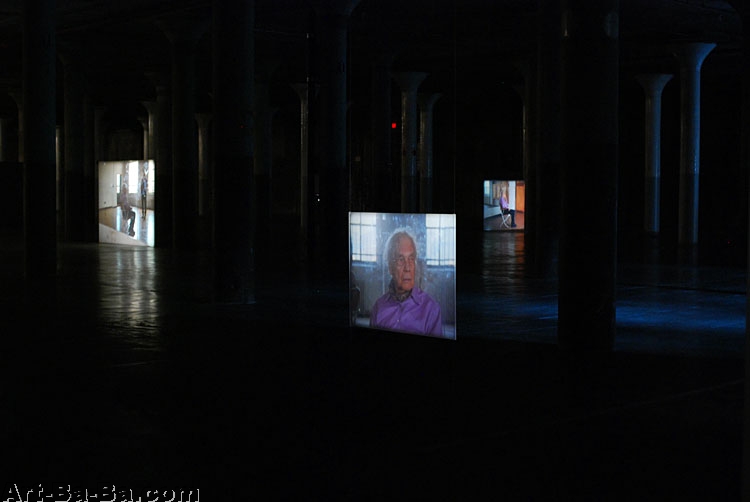[p_w_upload=100173]
塔希塔. 迪恩
Tacita Dean
[p_w_upload=100164]
上图:塔希塔. 迪恩
内容来源:Artinfo.com
胡筱潇/译
点击 -- 超级资料
纽约——艺术家塔希塔。迪恩,名为“模拟”的卓越的回顾展,2006年在巴塞尔的思考拉格开幕,这个名称完全合乎一个在数字技术普遍存在的时代中的艺术家,而这个艺术家用16MM胶卷作为她首要的媒介。胶卷,带有脆弱性,技术上的复杂性,以及退化的坏兆头,也伴随着它首要的主题:迪恩用过去的时光让人如此着迷,并且如此中肯,重要,甚至现实可以伴随着钟的滴答声消失。也许正如推论的那样,她用人类的脆弱让人着迷,也使用荒唐和虚华的一切。(2003年,在她令人痛苦的对意大利艺术家马里奥。莫兹的电影记录中,马里奥。莫兹 正处在死前的短暂时间中)。最著名的作品之一,“在海上消失I(1996)”,引用悲剧爱好者游艇主唐纳德。克罗赫斯特的故事,他通过小心翼翼地定时和不允许错误地坚持写日志,试图(但失败了)去周游世界获得第一个荣誉,但他从未离开过大西洋。
迪恩于1965年出生在坎特伯雷,最早被培养为一名画家,在评论中享有巨大的成功。“在海上消失I”让她赢得了1998年的特纳奖,当时她还在费城的当代艺术中心有一个个展。在2001年她在大不列颠泰特办了另一个个展,并于2006年获得雨果。博斯奖,随后又在所罗门。R。古根海姆美术馆举办个展。从2000年开始,她在柏林居住并工作,那里失败的共产主义政权结构的崩溃,已无疑在撞击和谐的情绪,这种情绪出现在她的电影中,如“Fernsehturm (2001) and Palast (2004).”
她最新的作品是一个六屏幕的电影装置,“2007年4月28日莫斯。坎宁安和特雷弗。卡尔森在纽约对着约翰。凯奇的作品表演静止(3次移动),4分33秒,” 9月1日在迪亚。比肯上演。坎宁安表演了一种新的舞蹈——坐在静止的椅子上——对着凯奇著名的无声作品,4分33秒(1952)。在上个月的这天,这件凯奇的作品公布于众,迪恩与ARTINFO做了关于坎宁安的谈话——她对他的记录,以及这个作品和她其他作品的关联。
塔希塔,你的作品常关于事物伴随着时间的推移而消逝。那么它又是在什么范围内关于死亡的?
当然,它从某种程度上关于死亡的一切,但是它又不是。我最近对年长的人们很有兴趣,但是作品还没有从某处诞生出来。马里奥。莫兹非常用心观察圣吉米纳诺(在托斯卡纳区,艺术家被邀请去那工作)。我觉得他和我爸爸的身体有很相似的地方,我不能停止我自己看他。每个人都说我不可能让他来这么做,但是一天下午他的妻子(艺术家玛丽莎。莫兹 ),开始尽最大可能地关注,这总是让他很局促不安,他需要一些关注。我盯着他看,我想这有用。但他后来去世了。
“赐予物修女”(2005)来自一个试图寻找考克(2005年欧洲文化之城)的方案,并要寻找一个修女的墓地,这引导我关注修女。当我到达考克我还没有任何主意将要做什么。所有的作品内容来自不同的地方。
我是否可以暗示这是一种执念。
唔,它在某种程度上确是一种执念。我喜欢年长的人们,理由是他们运载如此多的信息在他们的躯体中,在那一刻他们的生命中有一种难以置信的优雅。
那这件新作品是如何出来的呢?你开始和莫斯。坎宁安合作了吗?
我想做一些关于寂静的事物。英格兰的曼彻斯特电影节,我建议在作品中有非常多的噪音,我觉得所有的未知,就是我如何事半功倍,“也许我可以问一下莫斯。坎宁安”,负责人说。他已经用凯奇的4分33秒作为更大的舞蹈作品中的一部分,但我对他更感兴趣。我不像合作者那样接近他,但当然一旦你开始了,那它便变得非常迅速。
“寂静”这个作品中,莫斯的表演在你的电影里,是否似乎一种现存的舞蹈作品?
不,它是新的。美丽的事物是我不知道他将做什么,直到他出现在屏幕上。我被告知他将“坚持他的立场”,但我不知道这意味着什么。但他做的确实是如此的才华横溢。当你注视的时候,你会想任何事情——他所在的房间,晚年,当然,关于他自己,关于他和约翰。凯奇,以及寂静。复杂性是如此的惊异。
我已经想过这是4’33”的要点,在你创作这个作品前,你对它了解了多少呢?
我并不知道约翰。凯奇把它融入在3个移动里,即用钢琴盖的上下开合表示。这向我揭示莫斯是如何转换他的姿势,太完美了。
为什么是这样6个分离的屏幕去记录呢?
最初我打算只做一个给曼彻斯特电影节,但是莫斯做了6个行为过程——6已经是他的活动极限——我认识到他第一次做了这个作品的6个表演。还好我不认为这打断了舞蹈!每个表演我都有2个版本,因为我有2台摄像机——不一样地去摄像每个表演,我必须这么去做。一个装置便是完美的解决方案。
你用胶片记录的理由之一是它的暂时性。这个装置中的胶片可以保存多长时间?
你是说这些拷贝吗?一周内它们就是彻底的垃圾,因为它们连续地展现了几小时。我必须换掉这些拷贝。我们已经尽自己能力让这个循环系统完美。它是一种作为电影去保存胶片的方式,这便是我热爱的。
那是为什么呢?
因为胶片是寂静的一种媒介。它总是哑然无声。你可以不用声音拍摄,因此声音是分离的。它还是时间的一种媒介,因为伴随着电影,你面对着时间的滚动。这对你来说非常具有决定性——关于光,关于聚焦,关于任何事物。
这是对莫斯。坎宁安的敬意吗?
当然是的。但是我拒绝让它完全是单一的,因为它也是一种表演。
这是坎宁安对凯奇的敬意吗?
这是一个非常私人的问题,你必须要问莫斯。但是我想他绝对在思考凯奇,有些东西在那样的寂静的力量中。
作品:
[p_w_upload=100165]
"马里奥 莫兹" (2002), 静帧胶片
[p_w_upload=100166]
塔希塔。迪恩,“2007年4月28日莫斯。坎宁安和特雷弗。卡尔森在纽约对着约翰。凯奇的作品表演静止(3次移动),4分33秒,”



Tacita Dean
Artinfo.com
NEW YORK—Tacita Dean's major retrospective at Basel’s Schaulager in 2006 was called “Analogue,” a title entirely appropriate for an artist who, in an era of ubiquitous digital technology, employs 16mm film as her principal medium. Film, with its fragility, technical complexity, and threat of obsolescence, aligns with her preferred subjects as well: Dean is fascinated by the passage of time, and by how relevance, importance, and even truth can disappear with the ticking of a clock. Perhaps as a consequence she is fascinated by human frailty (evident in her poignant film portrait of Italian artist Mario Merz, made shortly before his death in 2003) and also by folly and the vainglorious. One of her best-known works, Disappearance at Sea I (1996), refers to the story of the tragic amateur yachtsman Donald Crowhurst, who attempted (and failed) to win, through careful timing and fastidious false log-keeping, first prize in a round-the-world race without ever leaving the Atlantic.
Dean, who was born in Canterbury in 1965 and trained originally as a painter, has enjoyed enormous critical success. Disappearance at Sea I won her a Turner Prize nomination in 1998, when she also had a solo show at Philadelphia’s Institute of Contemporary Art. In 2001 she had another at Tate Britain, and in 2006 she won the Hugo Boss Prize and the attendant solo show at the Solomon R. Guggenheim Museum. Since 2000 she has lived and worked in Berlin, where the architectural relics of the collapsed communist regime have clearly struck a sympathetic chord, appearing in films such as Fernsehturm (2001) and Palast (2004).
Her latest work is a six-screen film installation, Merce Cunningham performs STILLNESS (in three movements) to John Cage’s composition 4’33” with Trevor Carlson, New York City, 28 April 2007, on view at Dia Beacon through September 1. In it Cunningham performs a new choreography — sitting still in a chair — to Cage’s infamous silent piece, 4’33” (1952). On the day the piece was unveiled last month, Dean spoke to ARTINFO about Cunningham, her portrait of him, and its relationship to the rest of her work.
Tacita, your work is often about things slipping away with the passage of time. To what extent is it also about death?
Of course it’s all about that to some extent, but then again, it’s not at all. I’ve been quite interested in older people recently, but the work hasn’t all come out of one place. Every single film was done for a different reason. Mario Merz was very much about observing him in San Gimignano [in Tuscany, where both artists had been invited to work]. I thought he had a very strong physical resemblance to my father, and I just couldn’t stop looking at him. Everyone said there was no way I could ask him to do it, but one afternoon his wife [artist Marisa Merz] was getting most of the attention, which always made him rather uncomfortable, and he needed some attention. There I was gazing at him, and I think that helped. He died just afterward.
Presentation Sisters (2005) came from trying to find a project for Cork [the European City of Culture in 2005] and finding a nun’s graveyard, which led me to the nuns. It was just one of those gifts of the moment: When I arrived in Cork I had no idea I was going to be doing that at all. All these pieces come from different places.
I wasn’t suggesting an obsession.
Well, it is an obsession to a certain extent. The reason that I like older people is that they carry so much information in their bodies and have an incredible grace about them at that point in their lives.
How did this new piece come about? Did you set out to collaborate with Merce Cunningham?
I wanted to do something about silence. The Manchester Festival in England, to whom I proposed the work, was going to have a lot of noise in it, so I thought, in total ignorance, which is how I work half the time, “Maybe I could ask Merce Cunningham.” He had used Cage’s 4’33” as part of a bigger choreographed piece, but I was more interested in him. I didn’t approach it like a collaboration, but of course once you begin it, it becomes one immediately.
Was Stillness, the piece that Merce performs in your film, an existing piece of choreography?
No, it’s new. The beautiful thing was I didn’t know what he was going to do until we turned on the cameras. I was told that he was going to “hold his position,” but I didn’t know what that meant. But what he did was just so brilliant. While you’re watching it you think about everything — about the room he’s in, about old age, of course, about him, about him and John Cage, and about silence. The complexity is amazing.
I’ve always thought that that was the point of 4’33”. How well did you know it before you made this piece?
I didn’t know that John Cage wrote it in three movements, which are marked by the piano lid going up and down. That was a revelation to me. How Merce did that was he just shifted his pose, which is really perfect.
What was the reason for doing six separate portraits?
Initially I was going to do just one take for Manchester, but Merce did six takes — six was the limit of his energy — and we all realized that he’d just done the first six performances of this work. Thank God I didn’t think of interrupting the dance! I had two versions of each — because I had two cameras — and I filmed each differently, so suddenly I had two-camera films of six different performances, and I had to do something with them. An installation became the perfect solution.
One of the reasons that you use film is its impermanence. How long will the film in this installation last?
These copies? Within a week they’ll get really trashed, because they’re shown for hours on end. We just have to change the copy. We’ve perfected this loop system as best we can. It’s a way of keeping film as film, which is my passion.
Why is that?
Because film is a medium of silence. It’s always mute. You can never film with sound, so sound is separate. And it’s also a medium of time, because with film you’re dealing with a roll of time. It makes you very decisive about light, about focus, about everything.
Is this an homage to Merce Cunningham?
Of course it is. But I’m refusing to have it be purely that because it’s also a performance.
Is it Cunningham’s homage to Cage?
That’s a very personal question. You’d have to ask Merce. But I think he’s definitely thinking about Cage. There’s something in the power of that stillness.